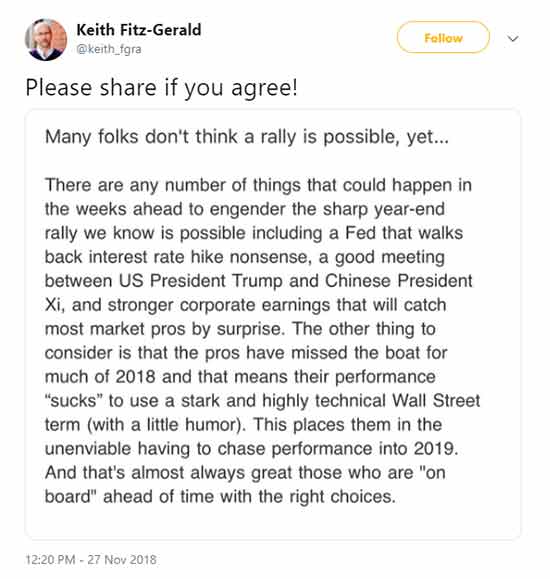Fed Chair Jerome Powell changed his tune last Wednesday morning, saying rates were much closer to “neutral” than they’ve been.
Not surprisingly, the markets shot higher, with the Dow tacking on 600+ points in its second best day of the year. All three averages gave some of that back immediately on Thursday, but no matter.
I’ve got to hand it to him.
Seems even “old dogs can learn new tricks.”
Powell’s language is a marked change from what he said in October, when he noted that rates were a “long way from neutral” and almost singlehandedly cratered U.S. markets.
CNBC’s Jim Cramer very succinctly noted shortly after the announcement that Powell’s “done the homework and he had to change his mind.” Like me, Cramer has been harshly critical of the Fed, and for many of the same reasons.
Now let’s see if Powell can resist meddling with the obvious.
Tariffs are still on the table, as are a whole host of other things that could gum up the works. Those include a global economic slowdown, politics, Brexit, a trade war… I could go on, but that wouldn’t do anyone any good.
Markets can and do change on a dime. Anybody going along for the ride “because everybody else is” will get clobbered (again). And sheep, as the old saying goes, will get slaughtered.
Obviously, I don’t ever want to see that happen to you.
In fact, the opposite is true.
My goal is for you to become a fabulously profitable investor, capable of building the wealth you deserve to live out life on your terms. And I started Total Wealth as a way to share the proven tips, tactics, and techniques that will help make that a reality.
Especially in circumstances like this, when everybody “knows” something to be true and bets accordingly.
Take Powell’s comments, for example.
Many investors were looking for an excuse to dump stocks coming into Wednesday’s trading, and the headlines were filled with perspective on how to avoid the coming bear market.
I, on the other hand, was in rally mode.
In keeping with something the legendary Jim Rogers told me years ago, “It makes sense to start looking at the other side of the trade when ‘everybody’ knows something to be true.”
I even went so far as to send out the following tweet Tuesday.

Honestly, I’m not any smarter than anybody else.
I simply knew that nobody wants to go down as being singlehandedly responsible for killing the longest-running bull market in history.
Including Fed Chairman Jerome Powell.
I totally underestimated the man.
He’s the first Fed Chair I am aware of who’s come even close to saying, “I was wrong” with regard to his prior assessment of rates and business conditions. I’m thinking about October specifically.
What he said Wednesday is not only a shift in what he’s communicating, but how.
I can only wonder “who” got to him.
So, Now What?
The CBOE’s VIX Volatility Index (VVIX) – a derivative of the more commonly tracked VIX you see widely quoted on the Internet and your nightly news – tracks the implied volatility of volatility itself, and has dropped like a rock in recent trading. What’s more, it’s failed to spike with each of the most recent big down days.
This is typically not behavior retail investors look at, but which I watch very closely.
Why?
Because the VVIX tracks the bets institutional traders are making when they bet on volatility itself. A drop like the one in play now suggests they expect volatility to decrease even if overall markets are in decline.
This is important because it’s typically behavior you see when the markets are trying to find a bottom and long before the indices everybody else watches reflect a reversal.
Interestingly, I’m not alone in making that observation.
Mark Sebastian, a volatility expert who appeared on CNBC earlier this week, shares that opinion. What’s more, he made the same observation from his research that I’m making today.
The markets can fall for short periods of time without the VIX rallying.
Admittedly, it’s nice to have company. Volatility is an esoteric discipline, albeit one that’s exceptionally important when it comes to hunting down profits in today’s highly computerized markets.
Speaking of which, it’s very tempting to view Powell’s remarks as the “end” to shoddy trading conditions, but I wouldn’t care to take that bet just yet.
Futures markets now reflect a 29% probability of two rate hikes in 2019 (down from three, prior to Powell’s remarks) after a widely expected 25% increase in December.
Ergo, we’re not out of the woods yet.
However, I’m not letting that stop me from hunting down the world’s best stocks.
I am particularly focused on companies like NVIDIA Corp. (Nasdaq: NVDA) at the moment.
The company has been a favorite of mine for a long time now because it is so tightly linked with three of the Unstoppable Trends we follow: Medicine, Technology, and War, Terrorism & Ugliness.
NVIDIA makes the graphic chips driving AI, which is now a critical component to just about every big, data-intensive process you can think of. What’s more, the company enjoys a 70% market share.
Within a quarter or two, I think Nvidia works through the inventory issues that led to reduced guidance and lowered expectations in June. I also believe traders will come roaring back when they realize that the company is still very much the leader customers think it is.
Q4 guidance, after all, is “only” $2.7 billion.
With a “b.”
At the end of the day, the question is not whether to buy or sell.
It’s how to invest in a trader’s market.
Thinking differently is a critical part of that process, and I will be with you every step of the way.
Even if there’s more selling ahead.
— Keith Fitz-Gerald
Source: Money Morning



